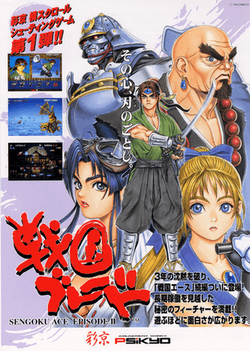Sengoku Blade
| Sengoku Blade | |
|---|---|
 Japanese arcade flyer | |
| Developer(s) | Psikyo |
| Publisher(s) |
Psikyo Taito (PS2) Atlus (SAT) Blue Bean Soft (Korea) MOBIRIX (mobile) |
| Designer(s) | Hirofumi Nakamura |
| Artist(s) | Tsukasa Jun |
| Composer(s) | Masaki Izutani |
| Series | Sengoku Ace |
| Platform(s) | Arcade, Sega Saturn, PlayStation 2, iOS, Android |
| Release date(s) |
Arcade
Saturn
PlayStation 2
|
| Genre(s) | Shoot 'em up |
| Mode(s) | Single player, co-op |
| Cabinet | Horizontal |
Sengoku Blade,[lower-alpha 1] also known as Tengai, is a horizontally scrolling shoot 'em up video game released for arcade machines in 1996 by Psikyo as a sequel to their 1993 shooter Sengoku Ace. A home console version was also released for the Sega Saturn. The game was ported years later to the PlayStation 2, and again for iOS and Android devices. The game is set in a historical fantasy version of the Sengoku period of Japanese history, featuring demons, magic and steam-powered robotics. It was followed by Sengoku Cannon: Sengoku Ace Episode III, released for the PlayStation Portable in 2005.
Gameplay

Sengoku Blade is horizontal-scrolling shoot 'em up.[1] The player may choose from five playable characters at the start and may unlocked two more.[2][3]:10-11 The game takes place in an imaginative and futuristic version of feudal Japan featuring ninjas and steam-powered machinery.[2][4] The Saturn version provides an option to choose a difficulty level between 1 and 7, configure controls, and set the amount of lives between 1 and 4.[3]:6-7 Items include a power-up to increase weapon power level, bombs, and bonus coins to increase score.[3]:8-9 Holding down the standard shot button can provide a more powerful shot.[2] If the player touches an enemy ship, their weapon power level will drop by one. The player will lose a life if they get hit by an enemy bullet. If all lives are lost, continues are provided. Once the game is beaten once, a second round will begin without the ability to use continues. Score rankings and other options can be saved to the system's memory.[3]:8-9
Release
Originally released for the arcades in 1996, Sengoku Blade was first ported to the Sega Saturn on November 22 of that same year.[5] This version was released as a two-disc double set, including a bonus omake CD-ROM which featured hundreds of Sengoku Ace series artworks (including the official art, guest art, and fan art from a contest by Psikyo), and now is rare and expensive to obtain.[4] Exclusive for the Saturn conversion was the implementation of voices during the brief cut scenes, and the addition of Marion from the Gunbird series as a bonus hidden character.[6]
In 2004, the game was also ported to PlayStation 2 as part of the Psikyo Shooting Collection Vol. 2: Sengoku Ace & Sengoku Blade by Taito, which was re-released one year later as a budget-range title. The Japanese release contains both Sengoku Ace and Sengoku Blade, but in Europe the two games were sold separately.[5] In 2014, the game was released internationally for iOS and Android mobile devices in Japanese, English and Korean.[1][7]
The game's manga adaptation was published on August 4, 1996.[8] The game's original soundtrack was released by Pony Canyon and Scitron on May 17, 1996.[9] Several PVC figures were also released for Koyori and Junis,[10][11] as well as for the demon-ninja villainess Kaen (火燕[12])[13] who has become one of the game's most popular characters.[14][15]
Reception
In a gamesTM retrospective, Sengoku Blade was found to be a simple but enjoyable shooter and given a score of 8 out of 10. They praised the unique graphical style and detail and compared the game favorably to Psikyo's earlier shooter Gunbird.[2] In 1997, the Japanese Sega Saturn Magazine ranked the game's Koyori as the 47th best female character on the platform.[16] The Saturn version has become a collector's item.[2][4]
Notes
- ↑ Sengoku Blade (戦国ブレード|Sengoku Burēdo) fully titled Sengoku Blade: Sengoku Ace Episode II
References
- 1 2 "Arcade Shoot-Em-Up Tengai Reappears For Smartphones". Siliconera. 2014-06-14. Retrieved 2016-04-01.
- 1 2 3 4 5 "gamesTM 27". Archive.org. Retrieved 2014-05-04.
- 1 2 3 4 Sengoku Blade (instruction manual) (NTSC-J, Sega Saturn ed.). Atluls. 1996.
- 1 2 3 "Reportaje Juegos Ocultos y Olvidados, Vol 10 PC". MeriStation.com.mx. 2014-11-30. Retrieved 2016-04-01.
- 1 2 "Sengoku Blade". Arcade Gear. Retrieved 2014-05-04.
- ↑ "Sengoku Blade Koyori & Marion translated dialogues (Sega Saturn)". YouTube. 2010-12-29. Retrieved 2013-09-11.
- ↑ "戦国ブレードがせっかく移植されたのに、おっぱいが見えないだけで騒ぐゲーマーの見苦しさ - iPhoneゲーマーな日々". Gamecast-blog.com. 2014-06-05. Retrieved 2016-04-01.
- ↑ "刃−Yaiba−". Interq.or.jp. Retrieved 2014-05-04.
- ↑ "PCCB-00216 | Sengoku Blade". VGMdb. Retrieved 2013-09-11.
- ↑ "Koyori ‹ Characters ‹ Encyclopedia - MyFigureCollection.net (Tsuki-board.net)". MyFigureCollection.net. Retrieved 2016-04-01.
- ↑ "Junis ‹ Characters ‹ Encyclopedia - MyFigureCollection.net (Tsuki-board.net)". MyFigureCollection.net. 2012-12-31. Retrieved 2016-04-01.
- ↑ "ゲームのおにゃのこ敵@ wiki - 戦国ブレード". 9.atwiki.jp. 1980-01-01. Retrieved 2016-04-01.
- ↑ "彩京 戦国ブレード 1/6 「火燕」 岡山フィギュア 新品 の通販 | カラメル". Calamel.jp. Retrieved 2016-04-01.
- ↑ "ロングソード連合プレイ日記 聞き取りレビュー2014 回答者:MLさん 戦国ブレード(サターン) 弱小チームには参加をご遠慮していただきましょうか、ねぇ?カナディアンマンさんにスペシャルマンさん". Gamaboy.ken-shin.net. Retrieved 2016-04-01.
- ↑ "年齢認証確認". DiGiket.com. Retrieved 2016-04-01.
- ↑ Sega Saturn Magazine (Japan) (25/1997): 129. 1997-07-25. Missing or empty
|title=(help)
External links
- (Japanese) Psikyo Shooting Collection Vol. 2: Sengoku Ace & Sengoku Blade official website
- Psikyo Shooting Collection Vol. 2: Sengoku Ace & Sengoku Blade at MobyGames
- Sengoku Blade at Giant Bomb